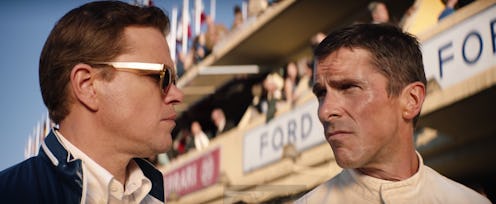Entertainment
What To Know About Car Racing's Greatest Rivalry Before Seeing 'Ford v Ferrari'

Heralded as the greatest rivalry in car racing, the feud between Henry Ford II and Enzo Ferrari came to a head in 1966 in the midst of one of the world's most grueling races: the 24 Hours of Le Mans. Ford v Ferrari, which premieres in theaters on Nov. 15, focuses on the Ford race team's preparations for that 1966 race, and although there's certainly plenty of drama and thrills to be had just looking at that race alone, there's actually a lot more to the true story behind Ford v Ferrari.
Ford v Ferrari tells the story of American carmaker Henry Ford II (Tracy Letts) and his showdown with Enzo Ferrari (Remo Girone), whose race cars dominated a race known as the 24 Hours of Le Mans. Specifically, it focuses on two people on Ford's race team: car designer Carroll Shelby (Matt Damon) and engineer and driver Ken Miles (Christian Bale), whose partnership saw them through a long, grueling, highly competitive race. Each of these characters is based on a real person who had a hand in developing and creating the first Ford car that was capable of not just completing but winning the race in 1966: the GT40 Mark II.
But Ford and Ferrari's rivalry dates back to before the 1966 race. Per Popular Mechanics, their rivalry began after Ford tried to buy Ferrari in 1963 as a way of getting the Ford Motor Company into developing race cars. At the time, Ferrari was almost exclusively focused on designing race cars and only designed street-legal cars to supplement their race team. Ferrari was set to accept the $10 million offer from Ford, but ultimately relented after he learned that Ford was trying to also control Ferrari's racing budget, which would grant him de facto control over the company's race operations. Following that busted deal, Ford turned to focus on creating and developing his own racing division, all geared towards beating Ferrari in a prestigious world race: the 24 Hours of Le Mans.
Ford v Ferrari follows many of these same beats, but it isn't a direct retelling, director James Mangold told IndieWire. "We’re close, but we’re shaping it for a narrative," he said. "There were more races than we could track." He also specifically called out trying to compact the race's extreme duration. "The only way to communicate that is to not do the 24-hour race in 11 minutes," he said. "We’re making Saving Private Ryan in reverse. We watch 90 minutes of drama, then go to war. The race itself is almost an hour, an immersion."
This rivalry — and indeed, this race — had a large influence on the automotive industry, thanks in no small part to the almost larger-than-life names that now make up this film's title. That the film is rooted in a very true, very real story gives it a good sense of grounding, a colorful backdrop for some fascinating drama to go with some good old-fashioned fast and furious thrills.
This article was originally published on